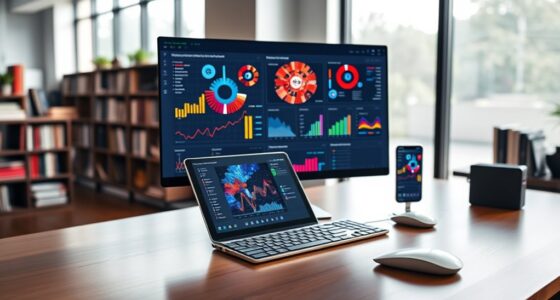AI-driven visualization is revolutionizing how you access personalized insights, making data more relevant and engaging. It moves beyond static reports to deliver dynamic, interactive visuals tailored to your preferences, goals, and behaviors. This trend enhances decision-making speed and confidence while enabling real-time data exploration. However, balancing personalization with privacy remains vital, requiring strong safeguards and transparency. Stay with us to discover how these advanced trends are shaping smarter, more responsive data experiences just for you.
Key Takeaways
- AI enables hyper-personalized visualizations by analyzing user behaviors, preferences, and goals for tailored data insights.
- Real-time data processing allows dynamic, interactive visuals that adapt instantly to user inputs and changing data streams.
- Personalization enhances user engagement and decision-making confidence through relevant, intuitive visual representations.
- Privacy protocols are vital to balance personalized insights with data security and build user trust in AI-driven visualization tools.
- Future trends focus on responsive, customizable visuals that combine deep personalization with ethical data handling practices.

Have you noticed how artificial intelligence is transforming the way we visualize data? It’s not just about making charts prettier or more interactive; AI enables you to deliver insights that feel tailor-made, fostering a deeper connection between you and your data. Hyper-personalized insights are revolutionizing how businesses and individuals interpret complex information, making data visualization more intuitive and relevant. Instead of static dashboards filled with generic metrics, AI analyzes your specific behaviors, preferences, and goals to craft visuals that resonate on a personal level. This customization boosts user engagement because you’re no longer sifting through irrelevant data—you’re presented with what truly matters to you, making decision-making faster and more confident.
However, with this level of personalization, data privacy becomes a critical concern. As AI tools mine vast amounts of user data to generate these insights, it’s crucial to ensure that your information remains secure. Responsible use of AI involves implementing strict data privacy protocols to protect sensitive details from breaches or misuse. When organizations prioritize transparency about how they collect and handle data, it builds trust and encourages more active participation. You’re more likely to engage with a visualization platform if you know your data is protected and used ethically. This mutual trust creates a positive feedback loop: better privacy safeguards lead to increased user engagement, which in turn provides richer data for AI to refine and personalize insights further.
Prioritizing data privacy builds trust and encourages engagement with AI-powered visualization tools.
AI-driven visualization trends also emphasize the importance of real-time data processing. As your data streams in, AI models analyze and visualize it instantly, allowing you to respond swiftly to emerging patterns. This immediacy keeps you engaged because it transforms static reports into dynamic, interactive experiences. You can explore different scenarios, drill down into specifics, or see how variables change over time—all tailored to your unique interests. Such hyper-personalization enhances user engagement because it makes data exploration more meaningful and less overwhelming. Instead of generic dashboards, you get a customized view that adapts to your evolving needs, helping you make smarter decisions faster. Additionally, leveraging expert voice actors for narration in visual storytelling can further elevate the engagement by adding authenticity and clarity to complex data narratives.
In essence, AI-driven visualization trends are shifting from one-size-fits-all reports to highly personalized, interactive experiences. While these innovations greatly boost user engagement, they also demand a strong focus on data privacy. Balancing personalization with security guarantees you benefit from hyper-personalized insights without compromising your trust or privacy. As AI continues to evolve, expect your data visualizations to become even more tailored, responsive, and engaging—driving you toward smarter, more informed actions.
Frequently Asked Questions
How Does AI Personalize Visualization for Individual User Preferences?
AI personalizes visualization by analyzing your user preferences and behavior patterns. It adapts the data visuals to highlight what matters most to you, making insights more relevant and engaging. This targeted approach boosts your user engagement because the content feels tailored and intuitive. By continuously learning from your interactions, AI guarantees that each visualization aligns with your evolving needs, creating a seamless, personalized experience that keeps you invested and informed.
What Are the Main Challenges in Implementing Hyper-Personalized Insights?
You might worry about user interface challenges and algorithm complexity when implementing hyper-personalized insights. The main difficulties include designing intuitive interfaces that adapt to individual needs while managing sophisticated algorithms that process vast data. Balancing usability with advanced computations can be tough, but focusing on user-centric design and optimizing algorithms helps. Clear communication and iterative testing guarantee your visualization remains accessible and accurate, ultimately enhancing user engagement.
How Does AI Ensure Data Privacy in Personalized Visualization?
AI guarantees data privacy in personalized visualization by using data encryption to protect your sensitive information from unauthorized access. It also relies on obtaining your explicit user consent before collecting or analyzing your data, ensuring transparency and control. This combination allows AI to deliver tailored insights while respecting your privacy, giving you confidence that your data stays secure and used responsibly.
Can Ai-Driven Visualization Adapt in Real-Time to Changing Data?
Sure, AI-driven visualization can adapt in real-time to dynamic data, transforming your screen into a living canvas of insights. It constantly monitors changes through real-time analytics, updating visuals instantly. Imagine a dashboard that shifts as your data does—like a chameleon blending into its environment. So, yes, your visualizations stay current, providing instant, actionable insights, all while you sit back and marvel at how seamlessly AI keeps pace with your evolving data landscape.
What Industries Benefit Most From Hyper-Personalized Visualization Trends?
You benefit most from hyper-personalized visualization trends in industries like retail, finance, and healthcare. These sectors use AI-driven insights for customer segmentation and marketing personalization, enabling you to tailor experiences and strategies effectively. By visualizing data in real-time, you can better understand individual preferences, optimize marketing efforts, and improve customer engagement. This approach helps you stay competitive and respond swiftly to changing customer needs and market dynamics.
Conclusion
As you explore these AI-driven visualization trends, remember that 85% of organizations report increased decision-making efficiency thanks to hyper-personalized insights. This statistic highlights how AI is transforming data into actionable, tailored visuals that empower you to make smarter choices faster. Embracing these trends means staying ahead in a data-driven world, where your ability to interpret and leverage customized insights can give you a significant competitive edge. Don’t overlook the power of AI in shaping your future success.









